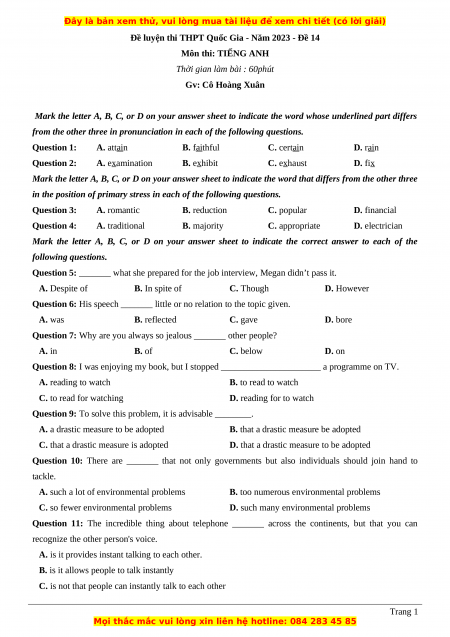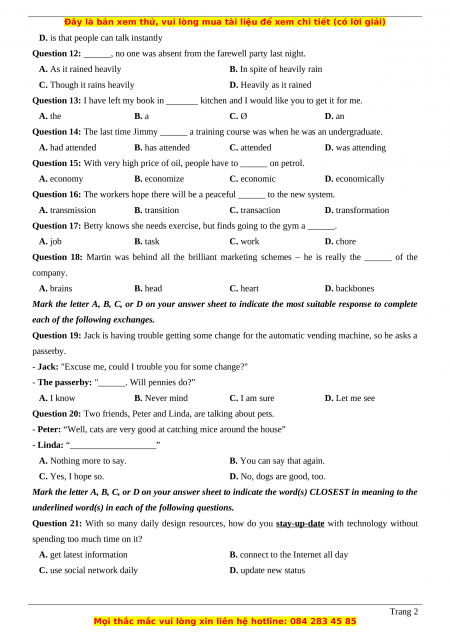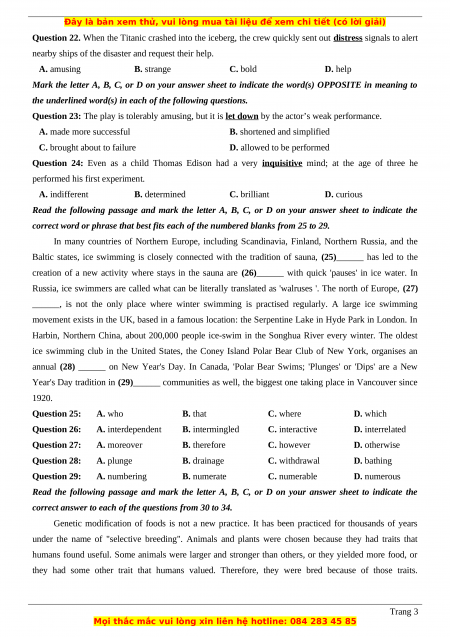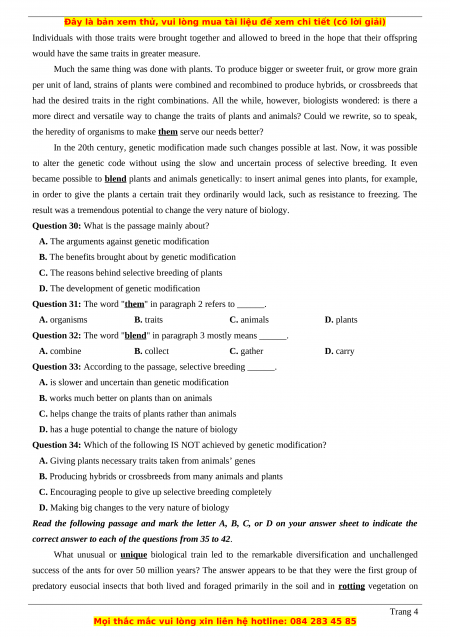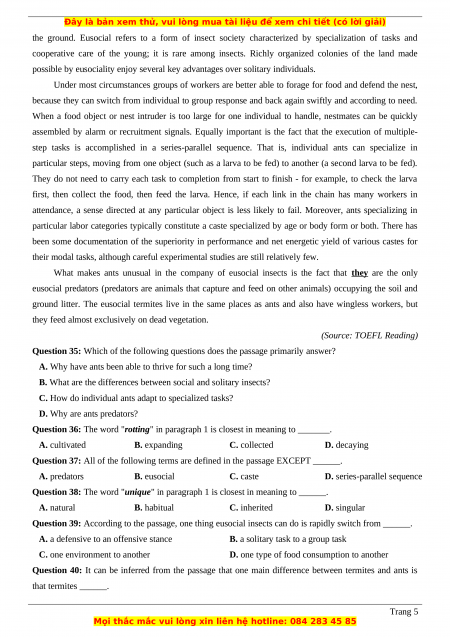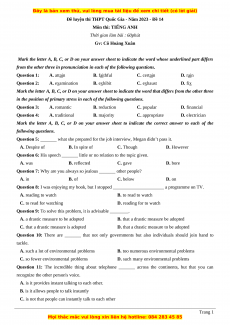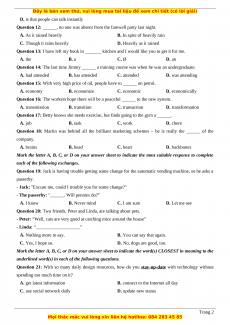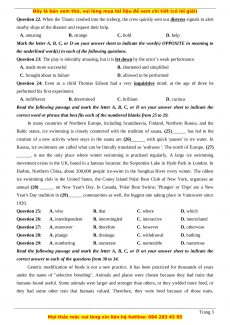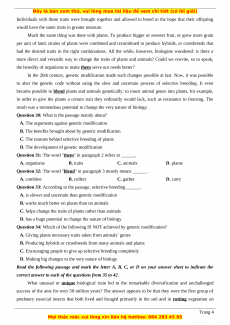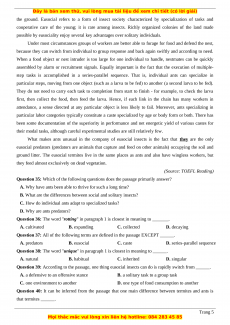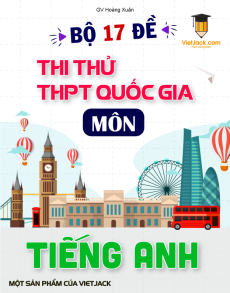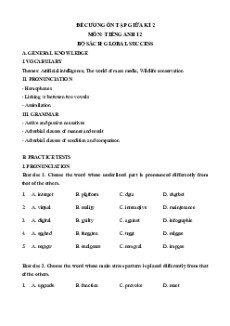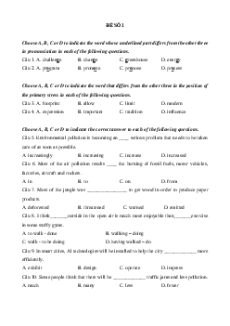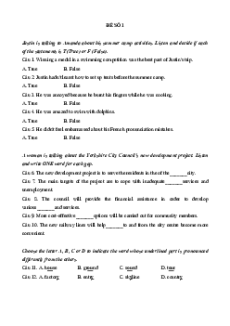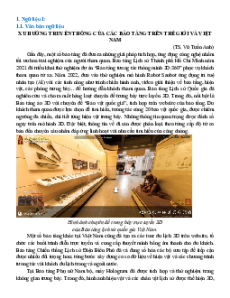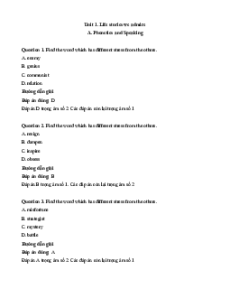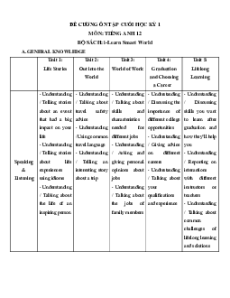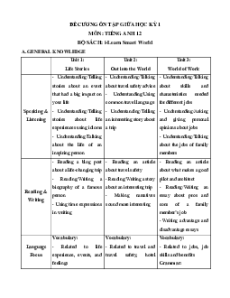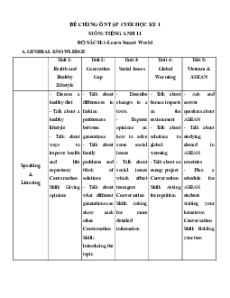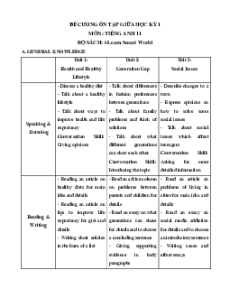Đề luyện thi THPT Quốc Gia - Năm 2023 - Đề 14 Môn thi: TIẾNG ANH
Thời gian làm bài : 60phút Gv: Cô Hoàng Xuân
Mark the letter A, B, C, or D on your answer sheet to indicate the word whose underlined part differs
from the other three in pronunciation in each of the following questions. Question 1: A. attain B. faithful C. certain D. rain Question 2: A. examination B. exhibit C. exhaust D. fix
Mark the letter A, B, C, or D on your answer sheet to indicate the word that differs from the other three
in the position of primary stress in each of the following questions. Question 3: A. romantic B. reduction C. popular D. financial Question 4: A. traditional B. majority C. appropriate D. electrician
Mark the letter A, B, C, or D on your answer sheet to indicate the correct answer to each of the
following questions.
Question 5: _______ what she prepared for the job interview, Megan didn’t pass it. A. Despite of B. In spite of C. Though D. However
Question 6: His speech _______ little or no relation to the topic given. A. was B. reflected C. gave D. bore
Question 7: Why are you always so jealous _______ other people? A. in B. of C. below D. on
Question 8: I was enjoying my book, but I stopped ______________________ a programme on TV. A. reading to watch B. to read to watch
C. to read for watching
D. reading for to watch
Question 9: To solve this problem, it is advisable ________.
A. a drastic measure to be adopted
B. that a drastic measure be adopted
C. that a drastic measure is adopted
D. that a drastic measure to be adopted
Question 10: There are _______ that not only governments but also individuals should join hand to tackle.
A. such a lot of environmental problems
B. too numerous environmental problems
C. so fewer environmental problems
D. such many environmental problems
Question 11: The incredible thing about telephone _______ across the continents, but that you can
recognize the other person's voice.
A. is it provides instant talking to each other.
B. is it allows people to talk instantly
C. is not that people can instantly talk to each other Trang 1
D. is that people can talk instantly
Question 12: ______, no one was absent from the farewell party last night.
A. As it rained heavily
B. In spite of heavily rain
C. Though it rains heavily
D. Heavily as it rained
Question 13: I have left my book in _______ kitchen and I would like you to get it for me. A. the B. a C. Ø D. an
Question 14: The last time Jimmy ______ a training course was when he was an undergraduate. A. had attended B. has attended C. attended D. was attending
Question 15: With very high price of oil, people have to ______ on petrol. A. economy B. economize C. economic D. economically
Question 16: The workers hope there will be a peaceful ______ to the new system. A. transmission B. transition C. transaction D. transformation
Question 17: Betty knows she needs exercise, but finds going to the gym a ______. A. job B. task C. work D. chore
Question 18: Martin was behind all the brilliant marketing schemes – he is really the ______ of the company. A. brains B. head C. heart D. backbones
Mark the letter A, B, C, or D on your answer sheet to indicate the most suitable response to complete
each of the following exchanges.
Question 19: Jack is having trouble getting some change for the automatic vending machine, so he asks a passerby.
- Jack: "Excuse me, could I trouble you for some change?"
- The passerby: "______. Will pennies do?” A. I know B. Never mind C. I am sure D. Let me see
Question 20: Two friends, Peter and Linda, are talking about pets.
- Peter: “Well, cats are very good at catching mice around the house”
- Linda: “___________________”
A. Nothing more to say.
B. You can say that again. C. Yes, I hope so.
D. No, dogs are good, too.
Mark the letter A, B, C, or D on your answer sheet to indicate the word(s) CLOSEST in meaning to the
underlined word(s) in each of the following questions.
Question 21: With so many daily design resources, how do you stay-up-date with technology without spending too much time on it?
A. get latest information
B. connect to the Internet all day
C. use social network daily D. update new status Trang 2
Question 22. When the Titanic crashed into the iceberg, the crew quickly sent out distress signals to alert
nearby ships of the disaster and request their help. A. amusing B. strange C. bold D. help
Mark the letter A, B, C, or D on your answer sheet to indicate the word(s) OPPOSITE in meaning to
the underlined word(s) in each of the following questions.
Question 23: The play is tolerably amusing, but it is let down by the actor’s weak performance.
A. made more successful
B. shortened and simplified
C. brought about to failure
D. allowed to be performed
Question 24: Even as a child Thomas Edison had a very inquisitive mind; at the age of three he
performed his first experiment. A. indifferent B. determined C. brilliant D. curious
Read the following passage and mark the letter A, B, C, or D on your answer sheet to indicate the
correct word or phrase that best fits each of the numbered blanks from 25 to 29.
In many countries of Northern Europe, including Scandinavia, Finland, Northern Russia, and the
Baltic states, ice swimming is closely connected with the tradition of sauna, (25)______ has led to the
creation of a new activity where stays in the sauna are (26)______ with quick 'pauses' in ice water. In
Russia, ice swimmers are called what can be literally translated as 'walruses '. The north of Europe, (27)
______, is not the only place where winter swimming is practised regularly. A large ice swimming
movement exists in the UK, based in a famous location: the Serpentine Lake in Hyde Park in London. In
Harbin, Northern China, about 200,000 people ice-swim in the Songhua River every winter. The oldest
ice swimming club in the United States, the Coney Island Polar Bear Club of New York, organises an
annual (28) ______ on New Year's Day. In Canada, 'Polar Bear Swims; 'Plunges' or 'Dips' are a New
Year's Day tradition in (29)______ communities as well, the biggest one taking place in Vancouver since 1920. Question 25: A. who B. that C. where D. which Question 26: A. interdependent B. intermingled C. interactive D. interrelated Question 27: A. moreover B. therefore C. however D. otherwise Question 28: A. plunge B. drainage C. withdrawal D. bathing Question 29: A. numbering B. numerate C. numerable D. numerous
Read the following passage and mark the letter A, B, C, or D on your answer sheet to indicate the
correct answer to each of the questions from 30 to 34.
Genetic modification of foods is not a new practice. It has been practiced for thousands of years
under the name of "selective breeding". Animals and plants were chosen because they had traits that
humans found useful. Some animals were larger and stronger than others, or they yielded more food, or
they had some other trait that humans valued. Therefore, they were bred because of those traits. Trang 3
Individuals with those traits were brought together and allowed to breed in the hope that their offspring
would have the same traits in greater measure.
Much the same thing was done with plants. To produce bigger or sweeter fruit, or grow more grain
per unit of land, strains of plants were combined and recombined to produce hybrids, or crossbreeds that
had the desired traits in the right combinations. All the while, however, biologists wondered: is there a
more direct and versatile way to change the traits of plants and animals? Could we rewrite, so to speak,
the heredity of organisms to make them serve our needs better?
In the 20th century, genetic modification made such changes possible at last. Now, it was possible
to alter the genetic code without using the slow and uncertain process of selective breeding. It even
became possible to blend plants and animals genetically: to insert animal genes into plants, for example,
in order to give the plants a certain trait they ordinarily would lack, such as resistance to freezing. The
result was a tremendous potential to change the very nature of biology.
Question 30: What is the passage mainly about?
A. The arguments against genetic modification
B. The benefits brought about by genetic modification
C. The reasons behind selective breeding of plants
D. The development of genetic modification
Question 31: The word "them" in paragraph 2 refers to ______. A. organisms B. traits C. animals D. plants
Question 32: The word "blend" in paragraph 3 mostly means ______. A. combine B. collect C. gather D. carry
Question 33: According to the passage, selective breeding ______.
A. is slower and uncertain than genetic modification
B. works much better on plants than on animals
C. helps change the traits of plants rather than animals
D. has a huge potential to change the nature of biology
Question 34: Which of the following IS NOT achieved by genetic modification?
A. Giving plants necessary traits taken from animals’ genes
B. Producing hybrids or crossbreeds from many animals and plants
C. Encouraging people to give up selective breeding completely
D. Making big changes to the very nature of biology
Read the following passage and mark the letter A, B, C, or D on your answer sheet to indicate the
correct answer to each of the questions from 35 to 42.
What unusual or unique biological train led to the remarkable diversification and unchallenged
success of the ants for over 50 million years? The answer appears to be that they were the first group of
predatory eusocial insects that both lived and foraged primarily in the soil and in rotting vegetation on Trang 4
the ground. Eusocial refers to a form of insect society characterized by specialization of tasks and
cooperative care of the young; it is rare among insects. Richly organized colonies of the land made
possible by eusociality enjoy several key advantages over solitary individuals.
Under most circumstances groups of workers are better able to forage for food and defend the nest,
because they can switch from individual to group response and back again swiftly and according to need.
When a food object or nest intruder is too large for one individual to handle, nestmates can be quickly
assembled by alarm or recruitment signals. Equally important is the fact that the execution of multiple-
step tasks is accomplished in a series-parallel sequence. That is, individual ants can specialize in
particular steps, moving from one object (such as a larva to be fed) to another (a second larva to be fed).
They do not need to carry each task to completion from start to finish - for example, to check the larva
first, then collect the food, then feed the larva. Hence, if each link in the chain has many workers in
attendance, a sense directed at any particular object is less likely to fail. Moreover, ants specializing in
particular labor categories typically constitute a caste specialized by age or body form or both. There has
been some documentation of the superiority in performance and net energetic yield of various castes for
their modal tasks, although careful experimental studies are still relatively few.
What makes ants unusual in the company of eusocial insects is the fact that they are the only
eusocial predators (predators are animals that capture and feed on other animals) occupying the soil and
ground litter. The eusocial termites live in the same places as ants and also have wingless workers, but
they feed almost exclusively on dead vegetation.
(Source: TOEFL Reading)
Question 35: Which of the following questions does the passage primarily answer?
A. Why have ants been able to thrive for such a long time?
B. What are the differences between social and solitary insects?
C. How do individual ants adapt to specialized tasks?
D. Why are ants predators?
Question 36: The word "rotting" in paragraph 1 is closest in meaning to _______. A. cultivated B. expanding C. collected D. decaying
Question 37: All of the following terms are defined in the passage EXCEPT ______. A. predators B. eusocial C. caste
D. series-parallel sequence
Question 38: The word "unique" in paragraph 1 is closest in meaning to ______. A. natural B. habitual C. inherited D. singular
Question 39: According to the passage, one thing eusocial insects can do is rapidly switch from ______.
A. a defensive to an offensive stance
B. a solitary task to a group task
C. one environment to another
D. one type of food consumption to another
Question 40: It can be inferred from the passage that one main difference between termites and ants is that termites ______. Trang 5
Đề thi thử THPT Quốc Gia môn Tiếng Anh có đáp án ( đề 14 ) - cô Hoàng Xuân
289
145 lượt tải
MUA NGAY ĐỂ XEM TOÀN BỘ TÀI LIỆU
CÁCH MUA:
- B1: Gửi phí vào TK:
1133836868- CT TNHH DAU TU VA DV GD VIETJACK - Ngân hàng MB (QR) - B2: Nhắn tin tới Zalo VietJack Official ( nhấn vào đây ) để xác nhận thanh toán và tải tài liệu - giáo án
Liên hệ ngay Hotline hỗ trợ: 084 283 45 85
Đề thi được cập nhật liên tục trong gói này từ nay đến hết tháng 6/2023. Chúng tôi đảm bảo đủ số lượng đề đã cam kết hoặc có thể nhiều hơn, tất cả có BẢN WORD, LỜI GIẢI CHI TIẾT và tải về dễ dàng.
Để tải tài liệu gốc về máy bạn click vào nút Tải Xuống ở trên!
Thuộc bộ (mua theo bộ để tiết kiệm hơn):
- Các đề thi được chọn lọc từ các trường Chuyên và Sở Giáo dục cả nước. Đảm bảo chất lượng, cấu trúc bám sát nhất với kì thì TN THPT 2023 môn Tiếng Anh.
- File word có lời giải chi tiết 100%.
- Đề thi mới sẽ được cập nhật tại gói này đến sát kì thi TN THPT 2023
- Mua trọn bộ sẽ tiết kiệm hơn tải lẻ 50%.
Đánh giá
4.6 / 5(289 )5
4
3
2
1
Trọng Bình
Tài liệu hay
Giúp ích cho tôi rất nhiều
Duy Trần
Tài liệu chuẩn
Rất thích tài liệu bên VJ soạn (bám sát chương trình dạy)
TÀI LIỆU BỘ BÁN CHẠY MÔN Tiếng Anh
Xem thêmTÀI LIỆU BỘ BÁN CHẠY Lớp 12
Xem thêmTài liệu bộ mới nhất

Đây là bản xem thử, vui lòng mua tài liệu để xem chi tiết (có lời giải)
Đề luyện thi THPT Quốc Gia - Năm 2023 - Đề 14
Môn thi: TIẾNG ANH
Thời gian làm bài : 60phút
Gv: Cô Hoàng Xuân
Mark the letter A, B, C, or D on your answer sheet to indicate the word whose underlined part differs
from the other three in pronunciation in each of the following questions.
Question 1: A. attain B. faithful C. certain D. rain
Question 2: A. examination B. exhibit C. exhaust D. fix
Mark the letter A, B, C, or D on your answer sheet to indicate the word that differs from the other three
in the position of primary stress in each of the following questions.
Question 3: A. romantic B. reduction C. popular D. financial
Question 4: A. traditional B. majority C. appropriate D. electrician
Mark the letter A, B, C, or D on your answer sheet to indicate the correct answer to each of the
following questions.
Question 5: _______ what she prepared for the job interview, Megan didn’t pass it.
A. Despite of B. In spite of C. Though D. However
Question 6: His speech _______ little or no relation to the topic given.
A. was B. reflected C. gave D. bore
Question 7: Why are you always so jealous _______ other people?
A. in B. of C. below D. on
Question 8: I was enjoying my book, but I stopped ______________________ a programme on TV.
A. reading to watch B. to read to watch
C. to read for watching D. reading for to watch
Question 9: To solve this problem, it is advisable ________.
A. a drastic measure to be adopted B. that a drastic measure be adopted
C. that a drastic measure is adopted D. that a drastic measure to be adopted
Question 10: There are _______ that not only governments but also individuals should join hand to
tackle.
A. such a lot of environmental problems B. too numerous environmental problems
C. so fewer environmental problems D. such many environmental problems
Question 11: The incredible thing about telephone _______ across the continents, but that you can
recognize the other person's voice.
A. is it provides instant talking to each other.
B. is it allows people to talk instantly
C. is not that people can instantly talk to each other
Trang 1
Mọi thắc mắc vui lòng xin liên hệ hotline: 084 283 45 85

Đây là bản xem thử, vui lòng mua tài liệu để xem chi tiết (có lời giải)
D. is that people can talk instantly
Question 12: ______, no one was absent from the farewell party last night.
A. As it rained heavily B. In spite of heavily rain
C. Though it rains heavily D. Heavily as it rained
Question 13: I have left my book in _______ kitchen and I would like you to get it for me.
A. the B. a C. Ø D. an
Question 14: The last time Jimmy ______ a training course was when he was an undergraduate.
A. had attended B. has attended C. attended D. was attending
Question 15: With very high price of oil, people have to ______ on petrol.
A. economy B. economize C. economic D. economically
Question 16: The workers hope there will be a peaceful ______ to the new system.
A. transmission B. transition C. transaction D. transformation
Question 17: Betty knows she needs exercise, but finds going to the gym a ______.
A. job B. task C. work D. chore
Question 18: Martin was behind all the brilliant marketing schemes – he is really the ______ of the
company.
A. brains B. head C. heart D. backbones
Mark the letter A, B, C, or D on your answer sheet to indicate the most suitable response to complete
each of the following exchanges.
Question 19: Jack is having trouble getting some change for the automatic vending machine, so he asks a
passerby.
- Jack: "Excuse me, could I trouble you for some change?"
- The passerby: "______. Will pennies do?”
A. I know B. Never mind C. I am sure D. Let me see
Question 20: Two friends, Peter and Linda, are talking about pets.
- Peter: “Well, cats are very good at catching mice around the house”
- Linda: “___________________”
A. Nothing more to say. B. You can say that again.
C. Yes, I hope so. D. No, dogs are good, too.
Mark the letter A, B, C, or D on your answer sheet to indicate the word(s) CLOSEST in meaning to the
underlined word(s) in each of the following questions.
Question 21: With so many daily design resources, how do you stay-up-date with technology without
spending too much time on it?
A. get latest information B. connect to the Internet all day
C. use social network daily D. update new status
Trang 2
Mọi thắc mắc vui lòng xin liên hệ hotline: 084 283 45 85

Đây là bản xem thử, vui lòng mua tài liệu để xem chi tiết (có lời giải)
Question 22. When the Titanic crashed into the iceberg, the crew quickly sent out distress signals to alert
nearby ships of the disaster and request their help.
A. amusing B. strange C. bold D. help
Mark the letter A, B, C, or D on your answer sheet to indicate the word(s) OPPOSITE in meaning to
the underlined word(s) in each of the following questions.
Question 23: The play is tolerably amusing, but it is let down by the actor’s weak performance.
A. made more successful B. shortened and simplified
C. brought about to failure D. allowed to be performed
Question 24: Even as a child Thomas Edison had a very inquisitive mind; at the age of three he
performed his first experiment.
A. indifferent B. determined C. brilliant D. curious
Read the following passage and mark the letter A, B, C, or D on your answer sheet to indicate the
correct word or phrase that best fits each of the numbered blanks from 25 to 29.
In many countries of Northern Europe, including Scandinavia, Finland, Northern Russia, and the
Baltic states, ice swimming is closely connected with the tradition of sauna, (25)______ has led to the
creation of a new activity where stays in the sauna are (26)______ with quick 'pauses' in ice water. In
Russia, ice swimmers are called what can be literally translated as 'walruses '. The north of Europe, (27)
______, is not the only place where winter swimming is practised regularly. A large ice swimming
movement exists in the UK, based in a famous location: the Serpentine Lake in Hyde Park in London. In
Harbin, Northern China, about 200,000 people ice-swim in the Songhua River every winter. The oldest
ice swimming club in the United States, the Coney Island Polar Bear Club of New York, organises an
annual (28) ______ on New Year's Day. In Canada, 'Polar Bear Swims; 'Plunges' or 'Dips' are a New
Year's Day tradition in (29)______ communities as well, the biggest one taking place in Vancouver since
1920.
Question 25: A. who B. that C. where D. which
Question 26: A. interdependent B. intermingled C. interactive D. interrelated
Question 27: A. moreover B. therefore C. however D. otherwise
Question 28: A. plunge B. drainage C. withdrawal D. bathing
Question 29: A. numbering B. numerate C. numerable D. numerous
Read the following passage and mark the letter A, B, C, or D on your answer sheet to indicate the
correct answer to each of the questions from 30 to 34.
Genetic modification of foods is not a new practice. It has been practiced for thousands of years
under the name of "selective breeding". Animals and plants were chosen because they had traits that
humans found useful. Some animals were larger and stronger than others, or they yielded more food, or
they had some other trait that humans valued. Therefore, they were bred because of those traits.
Trang 3
Mọi thắc mắc vui lòng xin liên hệ hotline: 084 283 45 85

Đây là bản xem thử, vui lòng mua tài liệu để xem chi tiết (có lời giải)
Individuals with those traits were brought together and allowed to breed in the hope that their offspring
would have the same traits in greater measure.
Much the same thing was done with plants. To produce bigger or sweeter fruit, or grow more grain
per unit of land, strains of plants were combined and recombined to produce hybrids, or crossbreeds that
had the desired traits in the right combinations. All the while, however, biologists wondered: is there a
more direct and versatile way to change the traits of plants and animals? Could we rewrite, so to speak,
the heredity of organisms to make them serve our needs better?
In the 20th century, genetic modification made such changes possible at last. Now, it was possible
to alter the genetic code without using the slow and uncertain process of selective breeding. It even
became possible to blend plants and animals genetically: to insert animal genes into plants, for example,
in order to give the plants a certain trait they ordinarily would lack, such as resistance to freezing. The
result was a tremendous potential to change the very nature of biology.
Question 30: What is the passage mainly about?
A. The arguments against genetic modification
B. The benefits brought about by genetic modification
C. The reasons behind selective breeding of plants
D. The development of genetic modification
Question 31: The word "them" in paragraph 2 refers to ______.
A. organisms B. traits C. animals D. plants
Question 32: The word "blend" in paragraph 3 mostly means ______.
A. combine B. collect C. gather D. carry
Question 33: According to the passage, selective breeding ______.
A. is slower and uncertain than genetic modification
B. works much better on plants than on animals
C. helps change the traits of plants rather than animals
D. has a huge potential to change the nature of biology
Question 34: Which of the following IS NOT achieved by genetic modification?
A. Giving plants necessary traits taken from animals’ genes
B. Producing hybrids or crossbreeds from many animals and plants
C. Encouraging people to give up selective breeding completely
D. Making big changes to the very nature of biology
Read the following passage and mark the letter A, B, C, or D on your answer sheet to indicate the
correct answer to each of the questions from 35 to 42.
What unusual or unique biological train led to the remarkable diversification and unchallenged
success of the ants for over 50 million years? The answer appears to be that they were the first group of
predatory eusocial insects that both lived and foraged primarily in the soil and in rotting vegetation on
Trang 4
Mọi thắc mắc vui lòng xin liên hệ hotline: 084 283 45 85

Đây là bản xem thử, vui lòng mua tài liệu để xem chi tiết (có lời giải)
the ground. Eusocial refers to a form of insect society characterized by specialization of tasks and
cooperative care of the young; it is rare among insects. Richly organized colonies of the land made
possible by eusociality enjoy several key advantages over solitary individuals.
Under most circumstances groups of workers are better able to forage for food and defend the nest,
because they can switch from individual to group response and back again swiftly and according to need.
When a food object or nest intruder is too large for one individual to handle, nestmates can be quickly
assembled by alarm or recruitment signals. Equally important is the fact that the execution of multiple-
step tasks is accomplished in a series-parallel sequence. That is, individual ants can specialize in
particular steps, moving from one object (such as a larva to be fed) to another (a second larva to be fed).
They do not need to carry each task to completion from start to finish - for example, to check the larva
first, then collect the food, then feed the larva. Hence, if each link in the chain has many workers in
attendance, a sense directed at any particular object is less likely to fail. Moreover, ants specializing in
particular labor categories typically constitute a caste specialized by age or body form or both. There has
been some documentation of the superiority in performance and net energetic yield of various castes for
their modal tasks, although careful experimental studies are still relatively few.
What makes ants unusual in the company of eusocial insects is the fact that they are the only
eusocial predators (predators are animals that capture and feed on other animals) occupying the soil and
ground litter. The eusocial termites live in the same places as ants and also have wingless workers, but
they feed almost exclusively on dead vegetation.
(Source: TOEFL Reading)
Question 35: Which of the following questions does the passage primarily answer?
A. Why have ants been able to thrive for such a long time?
B. What are the differences between social and solitary insects?
C. How do individual ants adapt to specialized tasks?
D. Why are ants predators?
Question 36: The word "rotting" in paragraph 1 is closest in meaning to _______.
A. cultivated B. expanding C. collected D. decaying
Question 37: All of the following terms are defined in the passage EXCEPT ______.
A. predators B. eusocial C. caste D. series-parallel sequence
Question 38: The word "unique" in paragraph 1 is closest in meaning to ______.
A. natural B. habitual C. inherited D. singular
Question 39: According to the passage, one thing eusocial insects can do is rapidly switch from ______.
A. a defensive to an offensive stance B. a solitary task to a group task
C. one environment to another D. one type of food consumption to another
Question 40: It can be inferred from the passage that one main difference between termites and ants is
that termites ______.
Trang 5
Mọi thắc mắc vui lòng xin liên hệ hotline: 084 283 45 85
